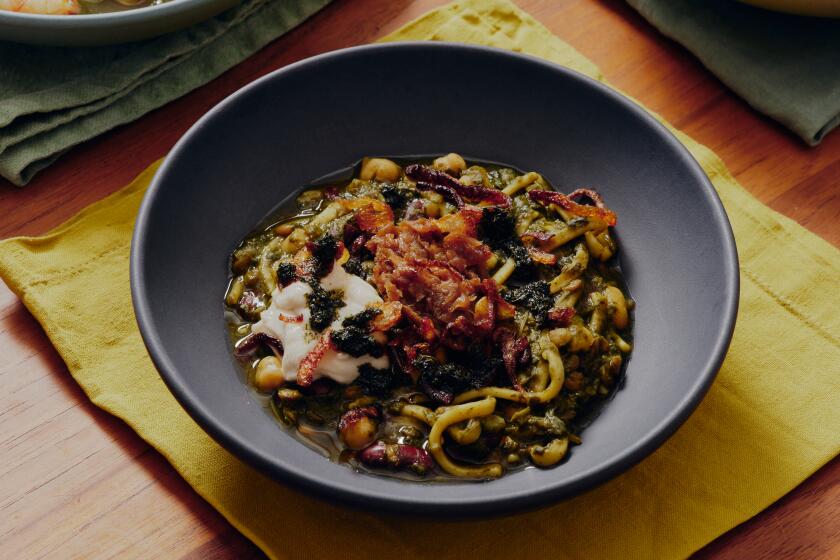Tomato marmalade
- Share via
Canning is having a moment.
So is pickling, preserving, jam making and all around “putting up,” as they used to say -- and now do once more -- of the season’s harvest. And if that puts you in mind of a remote farmhouse kitchen, gingham aprons and a cellar lined with rows of apple butter, then you haven’t been paying attention.
At Food in Jars, blogger Marisa McClellan makes peach-plum jam from a most unusual perch -- the 20th floor of a Philadelphia high-rise -- and draws more than 100,000 hits per month. In New York, Tigress in a Jam issues monthly jam challenges that are accepted by fellow bloggers around the globe. In Brooklyn, there’s Anarchy in a Jar, a blog-based business dedicated to getting you out of a jam-mergency (i.e., you are in dire need of jam). They deliver their homemade wares on bicycle.
Closer to home, there’s Saving the Season, a blog started on a whim just over a year ago by Kevin West to document his efforts to learn to can, jam, pickle and preserve his farmers market finds in his postage-stamp-sized kitchen tucked high above Laurel Canyon. His efforts just earned him a book deal.
That New Media has embraced this Old Favorite with such relish is the natural next step in our increasingly sophisticated food culture, West says. The notion of eating seasonally and locally is no longer niche -- it’s mainstream. And how else can you enjoy a just-picked, perfectly ripe, juicy-sweet nectarine in the dead of winter?
By canning it, of course.
“People just want to know how to do stuff,” West says. “And I think that jams and pickles are one of those things. In the ‘70s, there was the whole bread-baking thing. Last year, there was a whole bacon moment. Well, jams and jellies and pickles are the new bacon.”
McClellan, a food writer, launched her blog in early 2009 precisely because she saw an opening: “Nobody was just talking about canning and preserving,” she says. “But it has really exploded in the last few months.” She teaches canning classes and says demand is now greater than ever.
“There’s been a perfect storm: There’s an appreciation for eating locally and wanting to have high-quality things,” she said. “People are truly concerned about what is going into their food and want to make sure it is as healthy and chemical-free as possible. You can do that when you make it yourself.”
This canning-pickling-jamming craze isn’t just a trend, it’s a movement, says Amy McCann.
She and her husband, Matt Scheibe, are the bloggers behind Our Home Works, based in Eugene, Ore., which documents the couple’s effort to eat as locally as possible.
Preserves have the ability to strike a chord, to allow us to delight in the simple joy of farm-fresh fruits and vegetables, prepared by hand at home, McCann says. “People are always like, ‘Oh, wow, this is what strawberry jam is supposed to taste like.’ They really light up.”
Strawberry jam is just the beginning, however.
Valerie Gordon has begun teaching jam-making and preserving classes along with West at her Los Angeles boutique, Valerie Confections, and hosting private preserving parties. She tells her students that the real fun is all about experimenting -- with herbs, liquors, unexpected flavor combos -- and creating a signature taste and style.
“For the beginning canners, once they learn the basics, the world really starts to open up. They say, ‘I can pair anything I want?’ It’s a wonderfully liberating thing.”
And sweets are only half the fun.
--
Versatility
Gordon, who also sells her wares at the Hollywood farmers market, says that some of her customers’ favorites are on the savory side of the aisle, including a tomato marmalade brightened with citrus and a rich Santa Rosa plum ketchup layered with deep, smoky flavors.
Due to overwhelming class demand -- and everyone’s fear of having too many tomatoes and not enough recipes -- Gordon is adding a tomato class to the lineup Sept. 11, with students learning the finer points of canned tomatoes, ketchup and marmalade. Everyone goes home with a jar of each.
West, who is West Coast editor for fashion bible W magazine and is juggling the blog, classes and deadlines for his upcoming book (his publisher is Knopf, and it’s slated to be out in early 2012), says his goal is to inspire people who fear that canning is too much work or too dangerous or requires a farm. He wants people to preserve in much the same way that we’ve all learned, slowly but surely, to cook: year-round, along with the seasons, using fruits and vegetables from the market.
“A preserve is meant to extend the season a little bit,” he says. “We’re not trying to put something up for the bomb shelter 10 years from now. But if it’s apricot season, maybe you just put up 5 pounds of that and you’ll enjoy it until September.
“And in September, when you’re out of apricot jam, then you can put up some pears and maybe apple jellies. And then you can enjoy that into January when the citrus is really hitting its peak ... and you’ll get five jars out of that. And that will carry you through strawberry season, and then you’ve got five jars of that, and then you’re back at apricot season.
“You’re making and eating jam all year-round, and then you never have to make this huge effort to make ‘a year’s worth’ of something.”
As he speaks, he’s in his airy, sun-dappled kitchen. The counter is cluttered with canning jars of all sizes and colors, and there are spoons, spoons, spoons everywhere for tasting. A new recipe for apricot paste is reducing in the oven. Slender stalks of rhubarb -- a surprise find at the market so late in the season -- are nearby, waiting for his attention, as is a box of all the makings of some crisp, sweet-tart bread-and-butter pickles. The afternoon sun reflects off jars of blackberry and apricot preserves and an orange marmalade like they are jewels, which they are.
Is it really such a surprise, West asks, motioning to it all, that we’re embracing our culinary heritage?
He becomes quiet for a moment and begins ticking off a list of woes facing the world today -- the BP oil spill, Wall Street scoundrels, unemployment, voter skepticism ...
“If you’re afraid, uncertain, ambivalent, what do you do?” he asks. “I think you look to the past, you look to find stability and reassurance where you can find it.” He holds up a jar of asparagus spears he pickled earlier this year, tucking in a few tufts of tarragon and green garlic for good measure.
“This is stuff our grandparents were doing. And that is stuff that we can do in our own home. We can grow a zucchini in the backyard and put it up in a jar. And that is a certainty. That is a tangible, concrete certainty in this world of uncertainty.”
Using a standard vegetable peeler, peel the skin from the oranges in strips. Juice the oranges, saving 1 cup; the remainder can be saved for another use.
Place the juice, 1 cup sugar and the water into a medium saucepan and bring to a simmer over medium-high heat, then add the peel. Continue to heat until the mixture comes to a boil.
Reduce the heat to medium and continue cooking until the peel appears slightly translucent and very soft, approximately 10 minutes. Remove from heat and cool to room temperature.
While the orange peel is cooling, skin the tomatoes: Cut a small X at the base of each tomato. Bring a large pot of water to a boil, then drop the tomatoes in the water, several at a time. Remove the tomatoes with a slotted spoon when the skin has just begun peeling from the X, about 20 to 30 seconds. Immediately place the tomatoes in an ice bath to stop the cooking, then peel the skin from the tomatoes when they are cooled. Repeat until the skins are removed from all the tomatoes.
Seed and roughly chop the tomatoes and place them in a large pot. Stir in the remaining 5 cups sugar.
When the orange is cooled, chop the orange peel. Place the chopped orange peel in a small bowl, reserving the poaching liquid.
Heat the tomato and sugar mixture over high heat, stirring frequently with a large wooden spoon or heat-resistant spatula. Cook the marmalade until it begins to thicken, about 45 minutes to an hour. (It will boil and bubble furiously while it cooks; stir frequently but not constantly.)
Reduce the heat to medium-high and add the poached orange peel, salt and pepper, stirring constantly. Taste the marmalade. If you prefer stronger citrus notes, add some of the reserved poaching liquid now. Continue cooking until the marmalade is very shiny with a thick consistency.
Refrigerate the marmalade or can according to the jar manufacturer’s instructions.
Get our Cooking newsletter.
Your roundup of inspiring recipes and kitchen tricks.
You may occasionally receive promotional content from the Los Angeles Times.
















